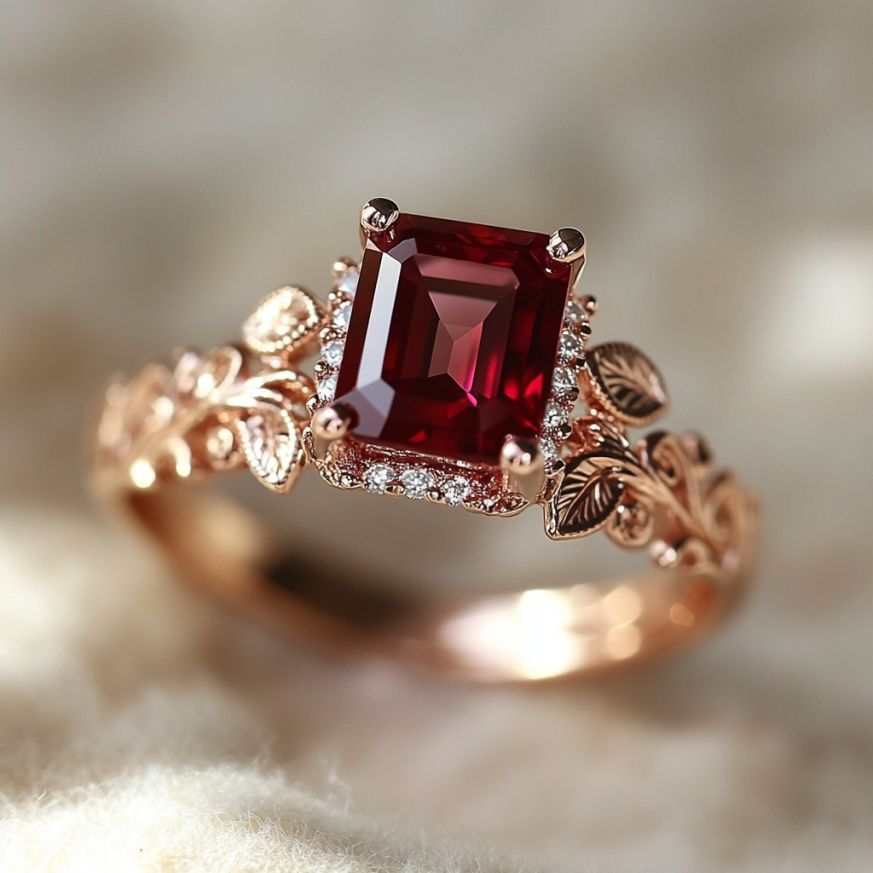Choosing Ruby Engagement Rings
Choosing Ruby Engagement Rings is a bold and timeless decision, symbolizing passion, love, and commitment. Known for their deep red hue and durability, rubies rank 9 on the Mohs hardness scale, making them ideal for everyday wear. However, choosing ruby engagement rings involves more than just picking a beautiful stone—it requires understanding quality factors, metal settings, and potential treatments. For those seeking a ring that’s as enduring as their love, choosing ruby engagement rings ensures a meaningful and lasting symbol of their relationship.

1. Selecting the Right Ruby Quality
Rubies vary in color, clarity, cut, and carat weight, influencing their beauty and price.
A. Color – The Most Important Factor
The most valuable rubies have a vivid, rich red hue with minimal secondary tones.
- Best Color: Pure red or slightly bluish-red, often called pigeon blood red.
- Less Valuable Tones: Purplish, brownish, or overly dark rubies.
B. Clarity – Fewer Inclusions Enhance Value
Rubies naturally contain inclusions, but eye-clean rubies (inclusions not visible to the naked eye) are the most sought after.
- Fine-Quality Rubies: Minimal inclusions, bright internal glow.
- Heavily Included Rubies: Cloudy appearance, lower durability.
C. Cut – Maximizing Brilliance
A well-cut ruby enhances light reflection and brilliance.
- Most Popular Cuts: Oval, cushion, and round cuts highlight a ruby’s depth and color.
- Avoid Deep or Shallow Cuts: These can make a ruby appear dull or smaller than its actual carat weight.
D. Carat Weight – Finding the Right Size
- Larger rubies over one carat are rare and significantly more expensive.
- A well-cut smaller ruby can appear larger due to strong color and brilliance.
2. Understanding Natural vs. Treated Rubies
Many rubies undergo treatments to enhance their appearance. Knowing whether a ruby is treated or untreated helps determine its true value.
A. Natural, Untreated Rubies – Highly Valuable
- No enhancements, making them rare and expensive.
- Often accompanied by a gemological certification.
B. Heat-Treated Rubies – Industry Standard
- Improves color and clarity naturally using heat.
- Widely accepted and more affordable than untreated rubies.
C. Fracture-Filled or Lead-Glass-Filled Rubies – Lower Quality
- Fillers are used to improve clarity but make the ruby more fragile.
- Less valuable and require extra care.
Tip: Always ask for a certification from GIA, AGL, or GRS to verify authenticity and treatments.

3. Choosing the Best Setting for a Ruby Engagement Ring
The setting affects both protection and style. Since rubies are valuable, selecting a secure setting ensures longevity.
- Bezel Setting: Fully encases the ruby in metal, offering maximum protection.
- Prong Setting: Enhances light exposure for brilliance but requires regular prong checks.
- Halo Setting: Surrounds the ruby with diamonds, enhancing its sparkle and size.
4. Selecting the Right Metal for Your Ruby Ring
The choice of metal enhances the ruby’s color and overall look.
- Yellow Gold: Complements deep red tones, giving a vintage appeal.
- White Gold or Platinum: Highlights a ruby’s brightness with a modern touch.
- Rose Gold: Blends beautifully with pinkish-red rubies, creating a warm, romantic feel.

5. Matching the Ruby Engagement Ring to Personal Style
A ruby ring should reflect the wearer’s personality and lifestyle.
- Classic & Timeless: Solitaire or halo setting with platinum or white gold.
- Vintage-Inspired: Ornate metalwork with yellow or rose gold.
- Modern & Minimalist: Bezel or prong setting with clean lines.
6. Ensuring Long-Term Durability and Care
A ruby engagement ring is an investment that requires proper care.
- Clean with mild soap and a soft brush—avoid harsh chemicals.
- Store separately from other gemstones to prevent scratches.
- Have the setting checked annually to ensure security.

Conclusion
Choosing a ruby engagement ring involves selecting the right color, clarity, cut, setting, and metal to create a meaningful and durable piece. Whether opting for a natural or treated ruby, a certified, well-set stone ensures beauty and value for a lifetime.
For more details, visit Preventing Ruby Wear Damage to learn how to protect your ruby from scratches, chips, and everyday wear.
